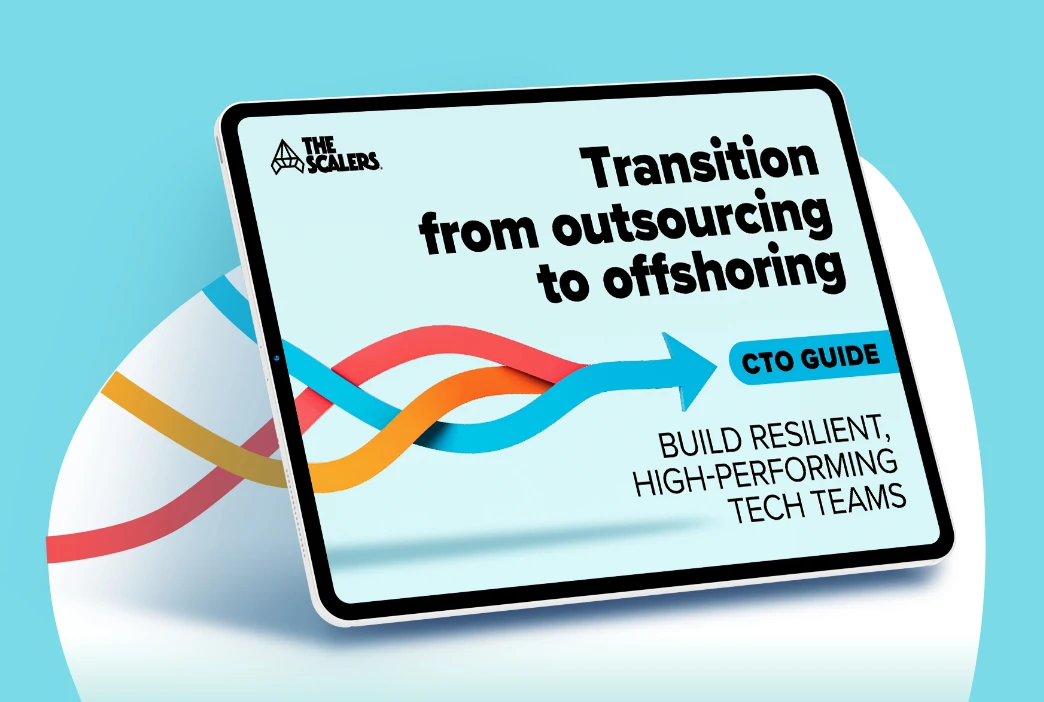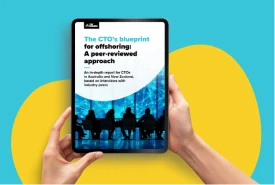- The H-1B visa fee is now $100,000 per employee.
- This increase is affecting US companies that rely on hiring highly skilled migrants, especially those in tech roles.
- Indian engineers are very much affected by the new visa fee, since they represent the majority of H-1B recipients.
- One of the most cost-effective alternatives to the H-1B visa is building offshore teams in talent-rich countries.
After the announcement of a massive surge in the fee for H-1B visas, US companies are staring at their budgets with a mix of disbelief and dread. What used to be a straightforward calculation for hiring top talent has turned into a financial nightmare that changes the economics of building teams.
The maths is brutal: bringing in that brilliant Indian software developer now costs you an extra $100,000 before they even write their first line of code!
In this article, we’ll break down how the new H-1B visa fee impacts your ability to hire these engineers, why it hits Indian professionals particularly hard, and most importantly, how CTOs are already pivoting to a solution that delivers the same world-class talent at a far lower cost.
The new H-1B visa fee explained: What changed for US companies?
The new H-1B visa fee is $100,000 per application, effective September 21, 2025. This applies to all new H-1B petitions, including those entering the 2026 lottery system.
To put this into perspective, companies were previously paying between $2,000 and $5,000 for an H-1B visa. That means they’ll now be paying 20 to 50 times more per application.
This measure is impacting STEM workers hardest, the exact talent pool CTOs depend on. The software engineers they were bringing from other countries to work in the US now cost approximately $266,000 in year one alone: $100,000 for the visa, an average salary of $128,000, plus benefits.
The fully loaded cost, including taxes and other employment-related expenses, can even exceed $300,000. It’s important to note that, at the time of writing this article, additional vetting costs are still being determined by the Department of Homeland Security. So that $100,000 per visa might just be the starting price.
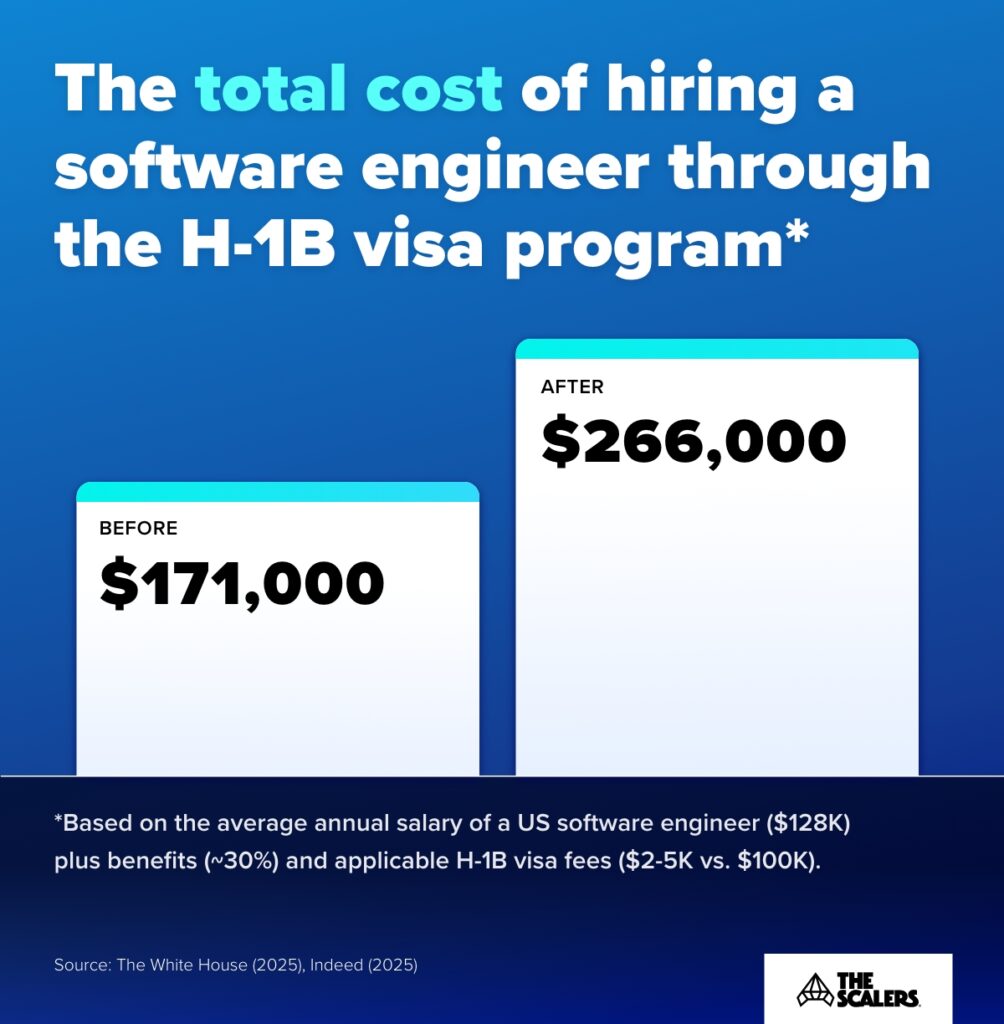
Why Indian engineers are hit hardest (and why that matters to you)
Indian nationals accounted for 71% of all H-1B visa recipients in FY 2024. The majority of them are tech professionals who’ve become integral to US innovation in companies of all sizes and industries.
For CTOs who used to hire Indian software developers via the H-1B program, the fee surge means their established recruiting channels for specialised STEM skills have now become prohibitively expensive or unavailable.
And it doesn’t only affect small and medium-sized companies, but also tech giants. For some, this may mean not thousands but millions in added expenses.
Amazon secured approximately 10,000 H-1B visas in 2025, making it the largest H-1B sponsor. Microsoft, Google, and Meta were also in the top 10, while Tesla’s H-1B approvals more than doubled from 328 in 2023 to 742 in 2024.
More H-1B visas were granted to software developers last year than for any other occupation, with Indians dominating roles in data science, AI/ML, and cloud architecture among skilled migrants in the US.
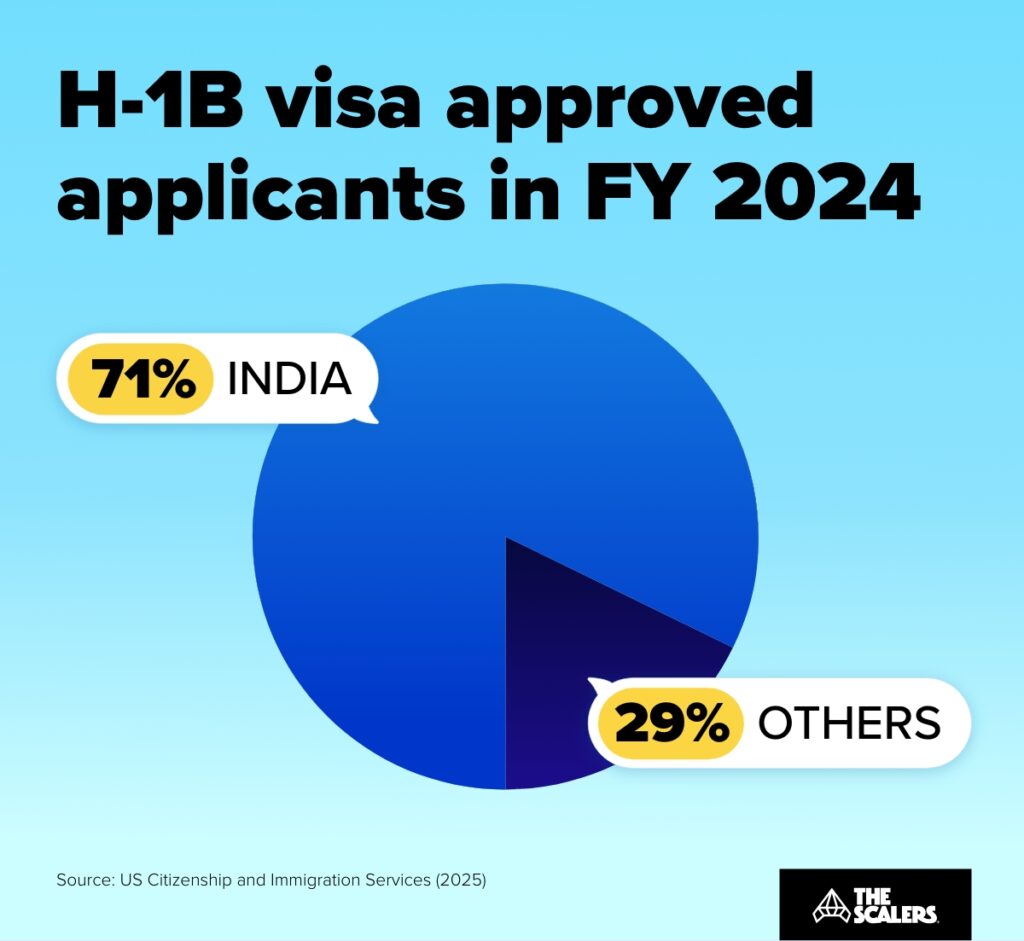
The true cost of the H-1B visa fee: Beyond the $100K sticker price
If you are a US tech leader in a small or mid-sized company, you must be aware of the potential ripple effects of the new H-1B visa fee:
- Your recruiting timelines can stretch from weeks to months as you navigate the new approval processes.
- You may be forced to settle for a less experienced or lower-quality candidate because the ideal candidate incurs a $100,000 premium.
- Your competitors may be able to absorb $100,000 per hire, so you’ll lose the talent war.
This situation can affect not only small and mid-sized companies that can’t afford the fee, but also firms in specialised domains like FinTech and AI/ML, which face a tougher reality. The talent pool was already small. Now it’s practically unreachable unless you’re a large corporation.
Still, there are alternatives to getting top Indian talent and building dedicated development teams, avoiding the $100,000 fee.
How CTOs can build a tech team without an H-1B visa
Companies that can’t afford the new H-1B visa fee when hiring Indian engineers have a more cost-effective option that doesn’t sacrifice quality: offshore software development.
By offshoring, you can build a team in tech hubs such as Bangalore at a much lower cost than in the US. Not for lesser talent, but for equivalent or superior engineers of the same quality as the ones you would hire locally.
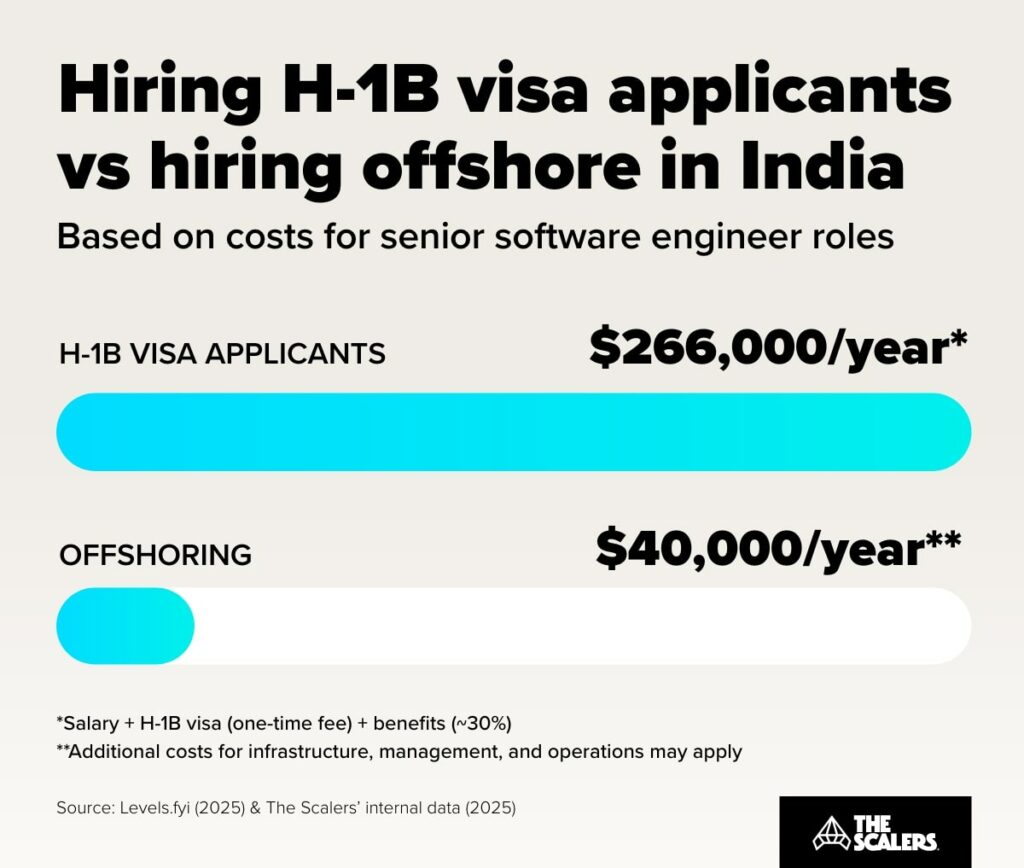
Known as the Silicon Valley of Asia, Bangalore is home to 2 million software engineers. The city accounts for 34% of India’s IT professionals and generates $53 billion in annual IT exports. The top engineering universities like IISc and IIIT Bangalore are right there, churning out the same calibre of engineers you’d hire on H-1B visas.
When we attended Shared Services & GCC Week India 2025 in Bangalore, we got the inside scoop from 200+ GCC leaders on how the city is growing and hosting innovation centres for core business functions.
Take PepsiCo, for instance. Their Indian capability centre is driving the company’s entire digital transformation. With over 1,500 AI agents deployed across their $92 billion business, the India team owns end-to-end development of technologies like IoT, digital twins, and process mining systems that optimise everything from warehouse operations to their massive private fleet.
What CTOs need to know about building offshore teams in India
Building an offshore team used to be just about savings, but today it’s also about accessing a talent pool that has become increasingly difficult to reach through traditional H-1B routes.
“When businesses started offshoring 45 years ago, they were looking for really, really cheap engineers,” Emilien Coquard, CEO at The Scalers, says. “It was all about costs. But over time, tech leaders realised that prioritising savings above quality was creating really bad software. Now, expertise is key. 10 years ago, we would see companies setting up offshore teams of 500+ mediocre engineers to save money, but today businesses are building smaller and smarter, investing a bit more into top talent and getting a lot back.”
The shift is already happening. Home to 57% of the global offshoring market and 1,800+ GCCs (Global Capability Centres), India has become arguably the fastest-growing offshoring destination in the world.
The infrastructure is already there. The country has mature ecosystems with Fortune 500 engineering centres, world-class educational institutions, and a culture of innovation that rivals any tech hub globally.
“The new H-1B fee fundamentally changes the economics of accessing Indian tech talent,” says Ryan Chana, Global Head of Advisory at The Scalers. “CTOs we talk to tell us the same thing: they can’t justify a $100k visa fee for a single hire when they could build a team of equally skilled or even more specialised engineers in Bangalore for half the cost. The maths has shifted from ‘Should we consider offshoring?’ to ‘How quickly can we set this up?’”
H-1B visa cost alternatives: The bottom line
The new H-1B visa fee is changing how US companies access global tech talent. Those willing or able to absorb a $100,000 fee will gain a major advantage, while others risk seeing their talent pipelines dry up.
But there’s another path. Instead of paying six figures just to bring one engineer to the US, you can build an offshore team with top engineers in a hub like Bangalore, often for the same or even less.
| Ready to explore how you can build an offshore team without the H-1B headache? At The Scalers, we’ve built over 130 dedicated development teams in Bangalore, with our unique model that ensures quality, retention, and integration with your existing operations. If you’re interested in exploring how we can help you hire a top team of Indian engineers, send us a message. Our experts will analyse your exact needs and help you build a world-class team! |
FAQs
Not if you hire strategically. Top offshore hubs like Bangalore produce engineers from the same elite institutions (IISc, IIIT) that feed H-1B pipelines, and many have experience working with Fortune 500 companies. The key is partnering with providers who prioritise talent quality over cost savings, ensuring you get senior developers with specialised skills.
Absolutely, as you’re often hiring from the same talent pool. 71% of H-1B recipients are Indian nationals who come from the same universities and tech ecosystems as offshore engineers in Bangalore, Pune, or Hyderabad.
While O-1 visas (for extraordinary ability), L-1 visas (for intracompany transfers), and TN visas (for Canadian/Mexican citizens) exist, they have strict eligibility requirements and don’t solve the core problem for most companies. The most practical alternative is building offshore teams that eliminate visa costs altogether while accessing a vast tech talent pool.
Offshoring lets you hire elite engineers in tech hubs like Bangalore without paying the $100,000 H-1B fee, visa processing delays, or relocation costs. You get the same calibre of talent at a fraction of the cost, with faster hiring timelines and no lottery uncertainty.
It depends on your needs: EOR works well for hiring a few scattered remote employees across different countries, while offshoring excels when you need a dedicated team in a specific tech hub with on-the-ground support. For most CTOs replacing H-1B hiring pipelines, offshoring offers better talent density, team cohesion, and infrastructure than managing individual EOR contractors.
Build Your Team,
Not Just a Contract
With The Scalers’ offshore dedicated development team, you get engineers who join your workflow for the long run. Grow steadily, stay flexible, and work with people who care about the product as much as you do.
